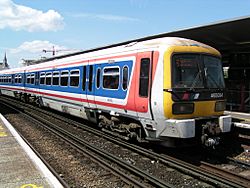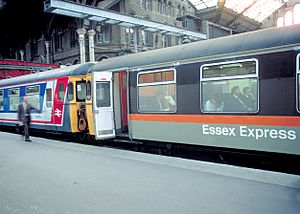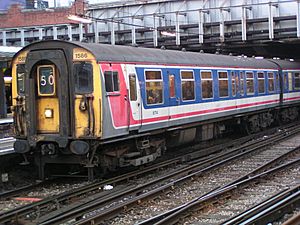Network SouthEast facts for kids
 |
|
| Franchise(s): | Not subject to franchising |
|---|---|
| Main region(s): | London, South East |
| Other region(s): | East of England, South West, West Midlands, East Midlands, Thames Valley |
| Fleet size: | Carriages: 6,700 (1986) |
| Stations called at: | 930 (1986) |
| Parent company: | British Rail |
Network SouthEast (NSE) was a special part of British Rail, which used to run all the trains in Britain. It was created in 1982. NSE mainly ran trains for people travelling to work in the London area. It also ran services between towns in busy parts of South East England. Before 1986, this part of British Rail was called London & South Eastern.
What was Network SouthEast?
Network SouthEast was one of three main groups that ran passenger trains for British Rail. It focused on busy routes around London and the South East. This meant lots of trains for people going to work or travelling between nearby cities.
NSE was known for its bright red, white, and blue colours. These colours were used on trains, stations, and signs. It helped people easily recognise the Network SouthEast brand.
Changes and Privatisation
Over time, the way trains were run in Britain changed. In the 1990s, British Rail was split up and sold to private companies. This process is called privatisation.
When Network SouthEast was privatised, its train lines were divided into many smaller parts. These parts were then sold to different private train companies. For example, some lines became Chiltern Railways, while others became South West Trains. This meant that the Network SouthEast name and its famous colours slowly disappeared from the railway.
Even though Network SouthEast no longer exists, its impact can still be seen. Many stations and some train designs still show hints of its classic red, white, and blue look.
Images for kids
-
Class 411 (4CEP) in modified NSE livery with rounded corners
-
Marylebone still with the red NSE livery for stations, around 30 years later in 2015. Marylebone was one of the stations given a facelift in the late 1980s.
-
NSE-era signage at Old Street station in September 2008
-
Farringdon station with a Class 319 on a Thameslink service.
-
Class 487 at Waterloo with a Waterloo & City line service.











